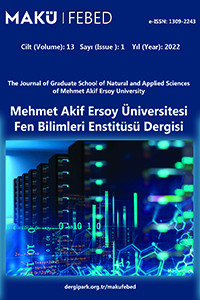Anoksik-aerobik Ardışık Kesikli Reaktörde Azot Giderme Performansına Farklı Asetik Asit/Propiyonik Asit Oranlarının Etkisi
Ardışık kesikli reaktör, azot giderimi, asetik asit, propiyonik asit, denitrifikasyon
Effect of Different Ratios of Acetic Acid to Propionic Acid on Nitrogen Removal Performance in Anoxic-Aerobic Sequencing Batch Reactor
___
- 1. APHA, AWWA, WCPF. (1998). Standard Methods for the Examination of Water and Wastewater, 20th Edition, American Public Health Association, Washington, D.C.
- 2. Beaubien, A., Hu, U., Bellahcen, D., Urbain, V., Chang, J. (1995). Monitoring metabolic activity of denitrification processes using gas production measurements, Water Research, 29 (10): 2269-2274.
- 3. Elefsiniotis, P., Li, D. (2006). The effect of temperature and carbon source on denitrification using volatile fatty acids, Biochemical Engineering Journal, 28, 148-155.
- 4. Elefsiniotis, P., Warehamb, D.G., Smith, M.O. (2004). Use of volatile fatty acids from anacid-phase digester for denitrification, Journal Biotechnology, 114: 289–297.
- 5. Fernandez-Nava, Y., Maranon, E., Castrillon, L. (2010). Denitrification of high nitrate concentration wastewater using alternative carbon sources, Journal of Hazardous Materials, 173: 682-688.
- 6. Ge, S., Peng, Y., Wang, S., Lu, C., Zhu, Y. (2012). Nitrite accumulation under constant temperature in anoxic denitrification process: The effects of carbon sources and COD/NO3-N, Bioresource Technology, 114: 137-143.
- 7. Gupta, S., Sharma, R. (1996). Biological oxidation of high strength nitrogenous wastewater, Water Research, 30 (3): 593-600.
- 8. Lee, N.M., Welander, T. (1996). The effect of different carbon sources on respiratory denitrification in biological wastewater treatment, Journal of Fermentation. Bioengineering, 82: 277–285.
- 9. Li, C., Cao, J., Ren, H., Tang, S. (2015). Comparison on kinetics and microbial community among denitrification process fed by different kinds of volatile fatty acids, Process Biochemistry, 50: 447-455.
- 10. McDonald, D.V. (1990). Denitrification by fluidized biofilm reactor, Water Science and Technology, 22: 451–461.
- 11. Obaja, D. Mace, S., Mata-Alvarez, J. (2005). Biological nutrient removal by a sequencing batch reactor (SBR) using an internal organic carbon source in digested piggery wastewater, Bioresource Technology, 96: 7–14.
- 12. Osaka, T., Shirotani, K., Yoshie, S., Tsuned,a S. (2008). Effects of carbon source on denitrification efficiency and microbial community structure in a saline, Water Research, 42: 3709–3718.
- 13. Pereira, M.A., Sousa, D.Z., Mota, M., Alves, M.M. (2004). Mineralization of LCFA associated with anaerobic sludge: kinetics, enhancement of methanogenic activity, and effect of VFA, Biotechnology and Bioengineering, 88 (4): 502–511.
- 14. Rodriguez, D.C., Pino, N., Periuela, G. (2011). Monitoring the removal of nitrogen by applying a nitrification-denitrification process in a Sequencing Batch Reactor (SBR), Bioresource Technology, 102 (3): 2316-2321.
- 15. Sawyer, C.N., McCarty, P.L., Parkin, G.F. (1994). Chemistry for environmental engineering. 4th ed. New York: McGraw-Hill.
- 16. Schuch, R., Gensicke, R., Merkel, K., Winter, J. (2000). Nitrogen and DOC removal from wastewater streams of the metal-working industry, Water Research, 34: 295–303.
- 17. Srinandan, C.S., Dsouza, G., Srivastava, N., Nayak, B.B., Nerurkar, A.S. (2012). Carbon sources influence the nitrate removal activity, commmunity structure and biofilm architecture, Bioresource Technology, 117: 292-299.
- 18. van Rijn, J., Tal, Y., Barak, Y. (1996). Influence of volatile fatty acids on nitrite accumulation by a Pseudomonas stutzeri strain isolated from a denitrifying fluidized bed reactor, Applied and Environmental Microbiology, 62 (7): 2615-2620.
- 19. Xu, Y.T. (1996). Volatile fatty acids carbon source for biological denitrification, Journal of Environmental Sciences, 8 (3): 257–268.
- 20. Zhang, H., Jiang, J., Li, M., Yan, F., Gong, C., Wang, Q. (2016). Biological nitrate removal using a food waste-drived carbon source in synthetic wastewater and real sewage, Journal of Environmental Management, 166: 407-413.
- 21. Zhao, L., Guo, J., Lian, J., Guo, Y., Yue, L., Gou, C., Zhang, C., Liu, X. (2015). Study of the dynamics and material transformation characteristics of nitrite denitrification in UASB, Biotechnology and Biotechnological Equipment, 29 (5): 907–914.
- 22. Zheng, X., Wu, R., Chen, Y.G. (2011). Effect of ZnO nanoparticles on wastewater biological nutrient and phosphorus removal, Environmental Science and Technology, 45 (7): 2826-2830.
- Yayın Aralığı: Yılda 2 Sayı
- Başlangıç: 2010
- Yayıncı: Burdur Mehmet Akif Ersoy Üniversitesi
Atıl Maden Ocaklarının Rekreasyonel Amaçlar için Kullanımı: Burdur Kenti Örneği
Latif Gürkan KAYA, Cengiz YÜCEDAĞ, Bora BİNGÖL
Yol Üstyapısında Kullanılan Cüruf Atıklarının Çevresel Etkilerinin İncelenmesi
Acı Yavşan Otu (Artemisia absinthium L.) Yaprak Uçucu Bileşenleri
Samim YAŞAR, Gürcan GÜLER, Abdullah BERAM, Demet COŞKUN, Dilek OZANSOY
Ötücü Kuşlarda (Passeriformes) Moleküler Cinsiyet Tayini ve Önemi
Bekir KABASAKAL, Tamer ALBAYRAK
Entomopatojen Fungusların Tuta absoluta Meyrick (Lepidoptera: Gelechiidae)’ ya Etkileri
Alime BAYINDIR, Ouidad ABDELAZIZ, Ali Kemal BİRGÜCÜ, Amar OUFROUKH, Mohamed Morad SENOUSSI, İsmail KARACA
İndüktif Eşleşmiş Plazma Optik Emisyon Spektroskopisi ile Patates, Elma ve Mısırda Ağır Metal Tayini
